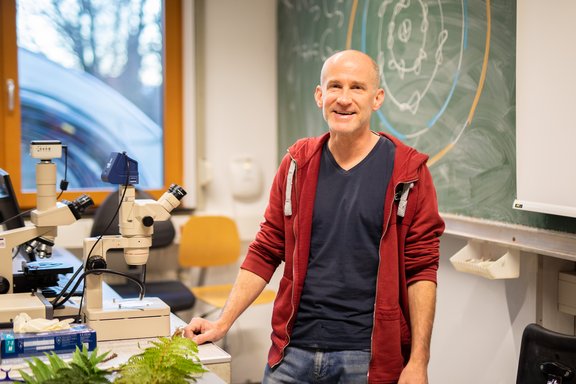Peter Schönswetter

Research Group Biodiversity
Research group leader
Room number 210
“I study the evolution and spatiotemporal diversification of plants from the Alps and other mountain ranges. I have a strong background in classical branches of botany such as floristics, biogeography and vegetation science, which I use to develop projects based on cutting-edge methodology. I am corresponding member of the Austrian Academy of Sciences and deputy chairman of the Advisory Board for the Protection of Nature of the Federal Government of the Tyrol. I am holding a full professorship at the University of Innsbruck since 2010. In addition, I am director of the Botanical Garden.”
Projects
Role of genome duplication in changing mountain landscapes, FWF, 2021–2025
Range formation of beech forest understory herbs, FWF, 2017–2021
Origin of steppe flora and fauna in inner-Alpine dry valleys, FWF, 2014–2017
Survey of the genetic diversity of endemics of the north-eastern Limestone Alps as a monitoring basis, Austrian Biodiversity Fond, 2024-2025
Selected Publications
- Kirschner, P., Perez, M., Záveská, E., Sanmartín, I., Marquer, L., Schlick-Steiner, B. C., Alvarez, N., STEPPE Consortium, Steiner, F. M., Schönswetter, P. (2022) Congruent evolutionary responses of European steppe biota to late Quaternary climate change: insights from convolutional neural network-based demographic modeling. Nature Communications 13, 1921. doi: 10.1038/s41467-022-29267-8
- Záveská, Z., Kirschner, P., Frajman, B., Wessely, J., Willner, W., Gattringer, A., Hülber, K., Lazić, D., Dobeš, C., & Schönswetter, P. (2021) Evidence for glacial refugia of the forest understorey species Helleborus niger (Ranunculaceae) in the Southern as well as in the Northern Limestone Alps. Frontiers in Plant Science 12:683043. doi: 10.3389/fpls.2021.683043.
- Kirschner, P., Záveská, E., Gamisch, A., Hilpold, A., Trucchi, E., Paun, O., Sanmartín, I., Schlick-Steiner, B. C., Frajman, B., Arthofer, W., The STEPPE Consortium, Steiner, F. M., Schönswetter, P. (2020) Long-term isolation of European steppe outposts boosts the biome’s conservation value. Nature Communications 11, 1968. https://doi.org/10.1038/s41467-020-15620-2.
- Sonnleitner, M., Hülber, K., Flatscher, R., Escobar García, P., Winkler, M., Suda, J., Schönswetter, P., & Schneeweiss, G. M. (2016) Ecological differentiation of diploid and polyploid cytotypes of Senecio carniolicus sensu lato (Asteraceae) is stronger in areas of sympatry. Annals of Botany, 117: 269–276.
- Schönswetter, P., Stehlik, I., Holderegger, R., & Tribsch, A. (2005). Molecular evidence for glacial refugia of mountain plants in the European Alps. Molecular Ecology, 14, 3547–3555.
All Publications ORCID Research Gate Google Scholar CV Peter Schönswetter
Additional research achievements
Community services
Corresponding Member of the Austrian Academy of Sciences
Deputy Chairman of the Advisory Board for the Protection of Nature of the Federal Government of the Tyrol
Editorial board/Reviewer for various journals and funding agencies
Head of the Curriculum Commission of the Faculty of Biology of the University of Innsbruck
Teaching
- Plant biodiversity
- Plant identification
- Botanical excursions to the Eastern Alps and other areas
- Flora and vegetation of the Alps and Middle Europe
- Population biology
